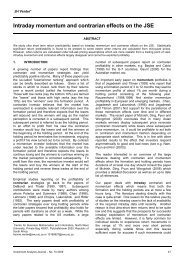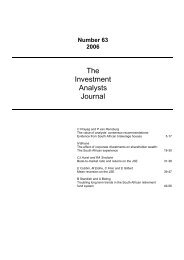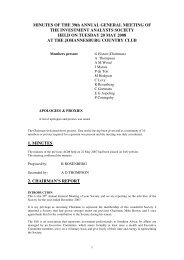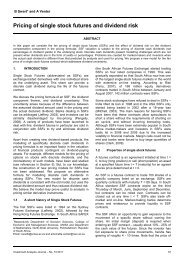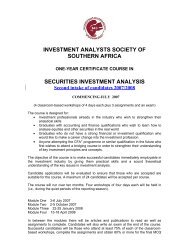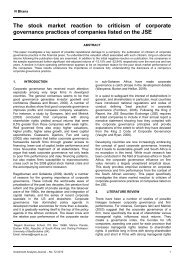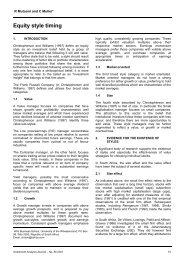The market reaction to capital expenditure announcements
The market reaction to capital expenditure announcements
The market reaction to capital expenditure announcements
You also want an ePaper? Increase the reach of your titles
YUMPU automatically turns print PDFs into web optimized ePapers that Google loves.
<strong>The</strong> <strong>market</strong> <strong>reaction</strong> <strong>to</strong> <strong>capital</strong> <strong>expenditure</strong> <strong>announcements</strong><br />
Investments in projects that reduce operating costs may<br />
also provide signals regarding the firm‟s investment<br />
opportunities. For example, Chan et al. (1995) identified<br />
positive abnormal returns earned by US firms<br />
announcing headquarters relocation decisions but<br />
negative abnormal returns for plant relocation<br />
<strong>announcements</strong>. However, where the relocation was<br />
motivated by business expansion or cost savings the<br />
<strong>market</strong> reacted positively whilst the <strong>market</strong> reacted<br />
negatively <strong>to</strong> decisions which would result in reduced<br />
capacity.<br />
One way <strong>to</strong> enter new <strong>market</strong>s, reduce production costs<br />
or share R&D costs is <strong>to</strong> form joint ventures. McConnell<br />
and Nantell (1985) found that <strong>announcements</strong> of<br />
domestic joint ventures resulted in significant positive<br />
announcement day returns. McConnell and Nantell<br />
speculated that the similarities between the <strong>market</strong><br />
<strong>reaction</strong>s <strong>to</strong> mergers and joint ventures might indicate an<br />
inter-corporate synergy effect as the source of the gains<br />
<strong>to</strong> shareholders, although they did not test this<br />
proposition. On the other hand, Chung, Koford, and Lee<br />
(1993) found <strong>announcements</strong> of international joint<br />
ventures by US firms had a negative effect on US firm<br />
values. Possible explanations for the negative wealth<br />
effects are fears regarding victimisation by hostile<br />
partners, diffusion of high-technologies and<br />
management conflicts (Chung et al., 1993).<br />
Bur<strong>to</strong>n, Lonie and Power (1999) examined UK<br />
<strong>announcements</strong> of joint ventures classified as<br />
immediately cash-generating and non-immediately cashgenerating<br />
investments. <strong>The</strong>y found significant positive<br />
returns for joint ventures but not for either of the other<br />
single company categories. <strong>The</strong>ir cross-sectional<br />
regressions examined whether a dummy variable for the<br />
availability of prior funding, announcement size,<br />
company size and <strong>market</strong>-<strong>to</strong>-book ratio were significant<br />
determinants of <strong>market</strong> <strong>reaction</strong> <strong>to</strong> individual <strong>capital</strong><br />
<strong>expenditure</strong> projects. <strong>The</strong> only significant variable was<br />
the announcement size for immediately cash-generating<br />
investments. Bur<strong>to</strong>n et al. (1999) do not fully explore the<br />
cause of the higher abnormal returns associated with<br />
joint ventures than with individual firm investment<br />
<strong>announcements</strong>, but suggest that it may be associated<br />
with synergistic gains, possibly associated with reduction<br />
in costs, spreading of risks, and the cross-fertilization of<br />
ideas.<br />
Johnson and Hous<strong>to</strong>n (2000) have found that joint<br />
ventures are being used for risky and complex<br />
transactions and for spreading costs. Frohls, Keown,<br />
McNabb and Martin (1998) similarly found joint ventures<br />
<strong>to</strong> be particularly beneficial when entering emerging<br />
<strong>market</strong>s, which may be riskier (for US companies) than<br />
transactions in other industrialized <strong>market</strong>s. Analysing<br />
strategic alliances rather than joint ventures, Chan,<br />
Kensinger, Keown and Martin (1997) found higher<br />
wealth creation where there was a transfer or pooling of<br />
technical knowledge.<br />
Woolridge and Snow (1990) investigated the <strong>market</strong><br />
<strong>reaction</strong> <strong>to</strong> various types of <strong>capital</strong> <strong>expenditure</strong>s. <strong>The</strong>y<br />
found that <strong>market</strong> <strong>reaction</strong>s <strong>to</strong> strategic investment<br />
<strong>announcements</strong> by US firms, which were generally<br />
significant and positive, were more consistent with<br />
shareholder wealth maximization than either “short-termism”<br />
imposed by institutional shareholders or their no<br />
<strong>reaction</strong> “rational expectations” hypothesis. Four types of<br />
<strong>capital</strong> investment <strong>announcements</strong> were analysed and<br />
significant abnormal returns were identified for each<br />
type: joint ventures (two-day cumulative <strong>market</strong>-adjusted<br />
return of 0,80%); R&D (1,13%); <strong>capital</strong> <strong>expenditure</strong><br />
(0,36%), and product/ <strong>market</strong> diversification (0,69%).<br />
<strong>The</strong> results of the Woolridge and Snow (1990) study<br />
suggest that not only are abnormal returns likely <strong>to</strong> be<br />
positive (0,64% overall), but that there may be<br />
identifiable differences in the level of abnormal returns<br />
for different types of <strong>capital</strong> <strong>expenditure</strong> <strong>announcements</strong>.<br />
Woolridge and Snow (1990) also examined whether<br />
project size (relative <strong>to</strong> the size of the firm) and project<br />
duration were important determinants of abnormal<br />
returns. <strong>The</strong>y found the <strong>market</strong> <strong>reaction</strong> <strong>to</strong> be identical<br />
for small and large projects, although they noted that the<br />
sub-sample for which classification was possible was<br />
mainly comprised of plant and equipment <strong>expenditure</strong>s.<br />
<strong>The</strong> <strong>market</strong> <strong>reaction</strong> <strong>to</strong> projects of short-term (less than<br />
three years) or long-term duration was also virtually<br />
identical, thus rejecting the hypothesis that the <strong>market</strong><br />
discouraged firms from making long-term investments.<br />
From a close analysis of the literature, it was decided <strong>to</strong><br />
test whether the shareholder wealth maximization or the<br />
rational expectations hypothesis is applicable <strong>to</strong> South<br />
African companies making <strong>capital</strong> <strong>expenditure</strong><br />
<strong>announcements</strong>. <strong>The</strong> following hypothesis was tested:<br />
H 1 : In a competitive <strong>market</strong> funds for <strong>capital</strong> <strong>expenditure</strong><br />
will be allocated <strong>to</strong> projects that enhance the firm‟s longterm<br />
prospects. <strong>The</strong>refore, the s<strong>to</strong>ck <strong>market</strong> will react<br />
positively <strong>to</strong> corporate <strong>announcements</strong> of <strong>capital</strong><br />
<strong>expenditure</strong> decisions <strong>to</strong> the extent that it enhances<br />
long-term profitability and maximizes firm value.<br />
As suggested by Wernfelt and Montgomery (1988) and<br />
Lang and Stulz (1994), focused firms tend <strong>to</strong> have better<br />
investment opportunities than highly diversified firms.<br />
Since firms with better investment opportunities are<br />
more likely <strong>to</strong> invest in positive net present value (NPV)<br />
projects (Lang, Stulz, and Walking (1991)), <strong>capital</strong><br />
investments by focused firms will be more worthwhile<br />
54 Investment Analysts Journal – No. 68 2008




